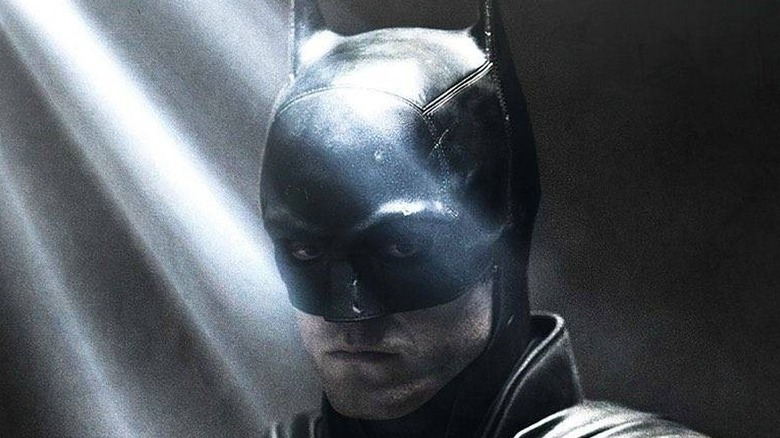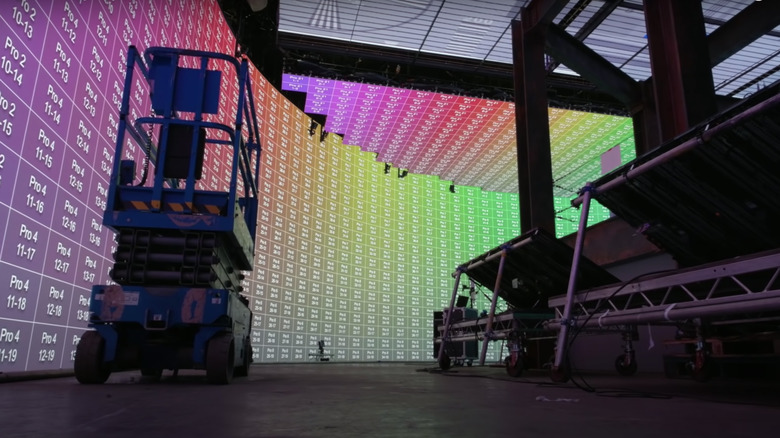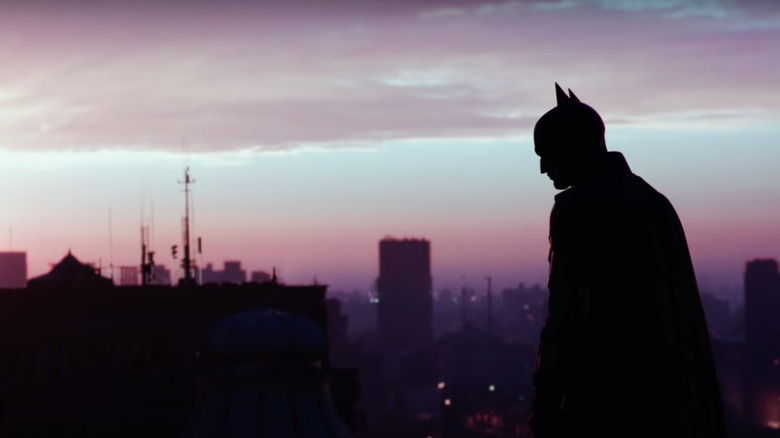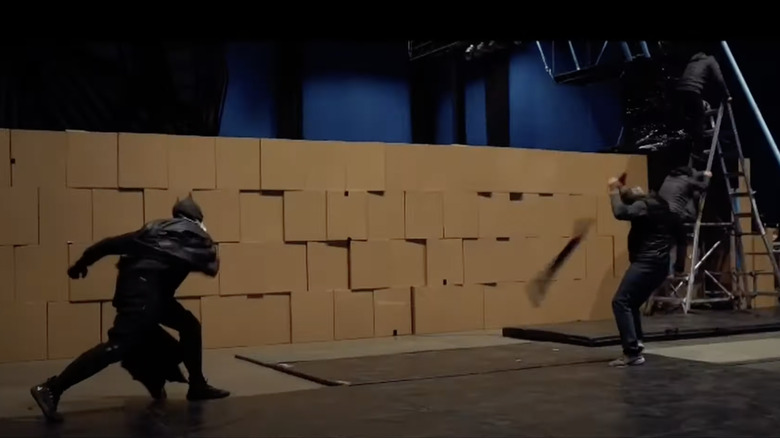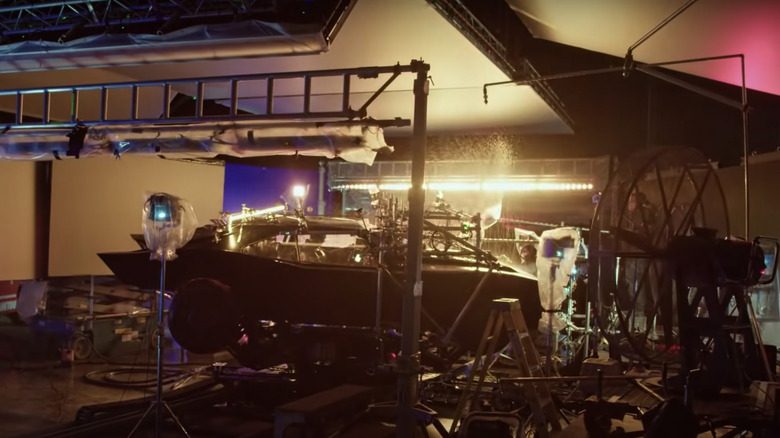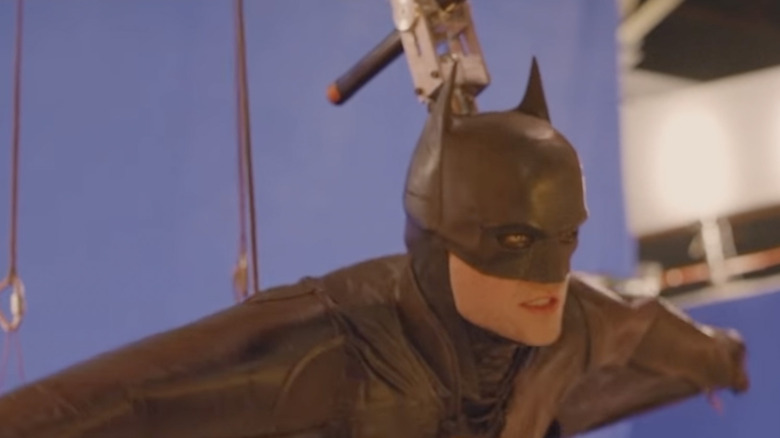What The Batman Looks Like Without The Special Effects
Not only is "The Batman" one of the most warmly-received films in the cinematic history of the Dark Knight, but it also ranks among the most re-watchable.
The film's stylistic grit, brooding introspection, and nuanced characterization has earned it an elite, distinctive spot in the pantheon; like Christopher Nolan's "The Dark Knight," Robert Pattinson's debut in the cape and cowl delivered an impressive enough take on the Caped Crusader to inspire loyalty and — in the spirit of the world's greatest detective — warrant closer inspection.
With help from behind-the-scenes videos and various production insiders, fans can get a peek at the strings pulling this Matt Reeves take on Gotham, as well as the movie magic that made it all seem so real. The latest in tech paired with meticulously-crafted practical sets, the film exists as both an anomaly in modern blockbuster films, and perhaps a blueprint for how to strike a similar balance in the future.
Gotham for real
"The city of Gotham is a character in the movie," says "The Batman" producer Dylan Clark. "To make it look real, you want to avoid anything that looks like bad visual effects shots."
Clark's vision for a realistic Gotham followed that of Reeves, who from the start of his involvement, expressed a commitment to practical effects. In the HBO Max featurette, Reeves and his crew demonstrate their collective follow-through on that commitment, showing off the very real, very detailed sets on which they shot.
Unlike CGI-embracing productions — such as the blue-screen heavy "Revenge of the Sith" — "The Batman" was shot on actual sets, using actual actors, all dressed in actual costuming. Though the crew left their backgrounds up to digital effects, the ground the actors stood on, the walls they leapt from, and the catwalks they fought upon were all as tangible as it gets.
Iconic Gotham locations like the Batcave, Wayne Tower, the Iceberg Lounge, and Carmine Falcone's office were all constructed with the utmost attention to detail, and it reads; behind the scenes footage shows oily puddles reflecting streetlights, wooden floorboards that bend with Batman's weight, and realistic rust and moss reclaiming the aging metropolis.
You can freeze time
In contrast to the thoroughly analog sets and props used in the production of "The Batman," the vast majority of the film's backgrounds, skylines, and vistas were created digitally. Just like the analog sets, however, all the film's digital technology was solely used to "create as photo-real an experience as we can," as production designer James Chinlund says. Using the newest in LED stage tech, the crew worked to marry the realism inherent in genuine camerawork and lighting with the convenience and robustness of computer-controlled scenery.
One of the coolest — and most time-saving — uses for the LED stage backgrounds is that, as VFX supervisor Dan Lemmon puts it, "you can essentially freeze time." The behind-the-scenes footage shows Robert Pattinson and Zoë Kravitz in place for a scene atop Wayne Tower while the crew freely adjusts the entire city skyline behind them. They rotate city streets and buildings, and even adjust the time of day between afternoon, sunset, and night. Compare that to the countless hours (and expense) a production like 1990's "Bonfire of the Vanities" spent on getting a single shot at the right time of day.
When combined with realistic cinematography, the LED backdrops look impressively real, and saved the cast and crew hours of shooting. In a world where even the quickest sequels take years to make, such expediency is more valuable than ever.
Genuine Grappling
Another key element of "The Batman" filmed largely practically was the combat. In an interview with NextShark, stunt coordinator Robert Alonzo explains at length the thorough, hands-on process by which he and his crew created all of the Dark Knight's fight scenes. As an experienced martial artist himself, Alonzo was able to train Pattinson and the stunt performers in realistic hand-to-hand combat — choreographing even Batman's mistakes.
As Alonzo said, he and Reeves wanted Batman's fighting style to be "grounded... real... very human... This is (only) his second year putting on the suit." To accomplish this extraordinary realism, Alonzo and crew guided Pattinson through fight rehearsals that highlighted Batman's combat prowess and athleticism, but made it clear that in his relative inexperience, his high threshold for pain was his greatest asset.
Pattinson's Batman is by far the most adept combatant on the battlefield in each of his encounters, but the fight choreography makes it clear (particularly when all effects are stripped away) that he is far from perfect. Two more interesting insights from the stunt practices are that Pattinson wore a mask during rehearsals (a portion of production occurred during the pandemic) and that he also wore the full Batsuit throughout — meaning, at times, he wore a mask over a mask.
Robert Pattinson's theme park ride
Similar to how the crew built Gotham by pairing real interiors with digital vistas, they built the Batmobile by building one very real vehicle and then surrounding it with digital roads.
This solution was the best of both worlds, as Pattinson was able to act out his scenes in the character's signature vehicle, and he was able to immerse himself in the car chase and ensuing explosions (rather than leaving that to a stuntman) by seeing them projected around him. As he steered the vehicle left and right, the intricate rig that held it up turned accordingly. The effect was amplified via fog, wind, and rain effects, and even dynamic lighting matching the city of Gotham.
Colin Farrell, who donned makeup "on steroids" to portray the Penguin, also had a custom vehicle rig built so he could interface with his role as realistically as Pattinson. Like the Batman actor, Farrell sat in a vehicle rig — twisting, turning, steering, and squinting to see through the wind-driven "rain," able to give the chase sequence his all. The end result, when viewed from the outside, is that both actors essentially experienced a theme park ride.
The Squirrel Suit
Of all the behind-the-scenes footage released in support of "The Batman," the most amusing might be revelations of how the wingsuit scene was filmed.
The actual scene sees the caped crusader stuck in the Gotham police headquarters, surrounded by dozens of armed officers — and the young, untested Batman not yet endeared to the vast majority. He makes a desperate escape, grappling his way up to the GCPD roof and donning his inflatable wingsuit to fly away.
Taken as it stands, the scene encapsulates the balancing act between prowess and inexperience that Reeves intended for Batman; the hero soaring down a Gotham avenue, "out of control" and awe-inspiring. In reality, the flight was filmed with two set-ups: one best described as a cute little plop, and the other looking like a high school production of "Peter Pan."
As revealed by IGN, Pattinson's initial dive off the roof was in reality just the actor in an inflatable suit falling a few feet onto padding. The subsequent gliding shots were all filmed by suspending Pattinson with a wire rig, while the actor grimaced as if he were in an actual, desperate free fall.
